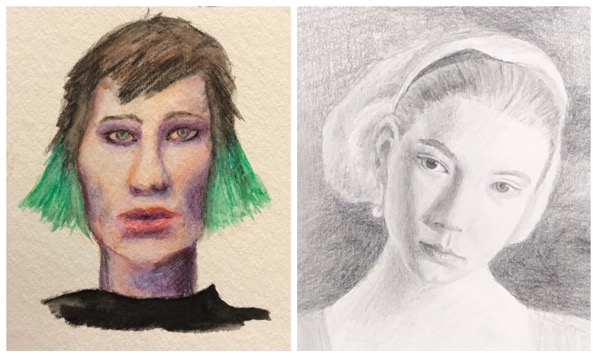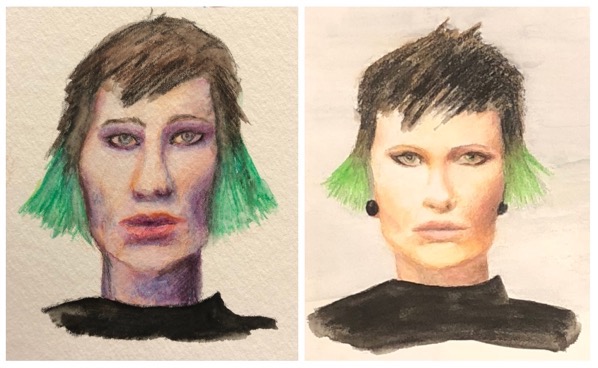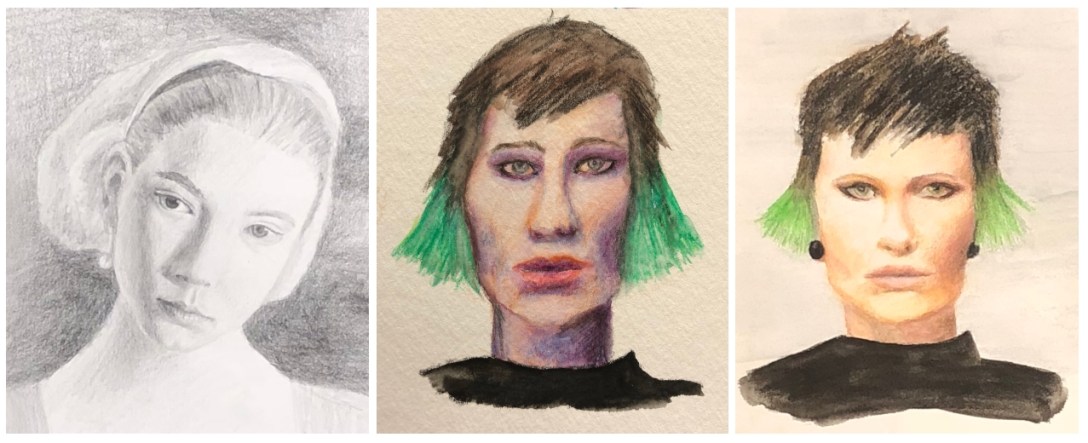If you like the work I do on this blog, please consider supporting it via my Patreon or a Ko-fi tip.
I think many of us tend to judge our progress of improvement in miniature painting by indicators like making first cut or placing in a contest, going from a bronze to silver then silver to gold medals in open shows, scores on sites like CMON or Putty & Paint, or even just getting a lot of likes and comments posting to social media sites like Facebook or Instagram.
 You probably think that the portrait on the right was drawn after the portrait on the left. (And some time after, at that!) You would be wrong. I drew them both last month, and the poorly drawn one was drawn after the better one. Yet overall I still feel pretty positive about my progress in learning to draw, and I think that I am improving. How can that be so? Read on to find out!
You probably think that the portrait on the right was drawn after the portrait on the left. (And some time after, at that!) You would be wrong. I drew them both last month, and the poorly drawn one was drawn after the better one. Yet overall I still feel pretty positive about my progress in learning to draw, and I think that I am improving. How can that be so? Read on to find out!
Contest placements and viewer responses absolutely can be valid markers of progress, and there’s nothing wrong with a little competitive spirit pushing you to strive and try new things! But when we rely only on those kinds of external judgments, we risk getting discouraged if they don’t come when we expect or when we feel like we need a little boost. It’s also possible to plateau for a while in terms of the objective ‘quality’ of your paint job, but still be improving by other measures. It’s not necessarily that we don’t value these other measures, but often other types of improvement are subtle enough that we overlook them, or dismiss their value.
So today let’s talk about how ‘getting better’ at an artistic skill encompasses a lot more than just generating a more attractive looking end result.
Faster
Speed is definitely an area to consider. If you can paint a figure of the same quality today in half the time or 75% of the time, or even 90% of the time that it used to take you, then that is definitely getting better. Faster means you’re can paint more figures within your allotted hobby time, or that you have some additional time to spend on each figure to work on pushing your skills with techniques and effects that eventually will drive your quality up a notch.
For my fellow super slow painters, the reverse is also true! If you are still taking 10 or 20 or however many hours to paint a figure, but you’re also gradually improving the quality of each, that still means you’re getting better and making progress. Do not despair!
And an important note – I’m talking about improving your speed using techniques/paints/tools with which you are familiar. When you try new things, you have to accept that it’s going to take you longer with them than with your usual methods and materials! I mention this because I’ve definitely been in the position of feeling like I should be able to just pick up something new and run with it because I’ve been painting for X amount of time or at Y level. There’s always a learning curve. If anything, the more practiced you are with one method and set of tools, the more of an initial hurdle of time and discomfort that you might have when trying something new.
 They didn’t just rebuild Steve Austin to be BETTER. They also rebuilt him FASTER and STRONGER.
They didn’t just rebuild Steve Austin to be BETTER. They also rebuilt him FASTER and STRONGER.
Stronger (or Easier)
When you first started to paint, almost everything seemed like a challenge and required a lot of focused concentration. Just figuring out how to hold the brush and the miniature and then getting the paint to go close to where you wanted it (and not on top of something else you just painted.) Then you start learning next steps like making washes or applying drybrushing, or maybe painting layers or wetblending. If you’ve been painting a while, likely you then tried your hand at trickier effects, like non-metallic metal or source lighting or whatever else.
Whatever stage of the miniature painting journey that you’re on, the elements you’re trying to master right now are challenging and often it may often seem like you take one step forward and two steps back. But very likely you’re forgetting how much you’ve learned in previous stages.
When you first started painting everything was challenging and required concentration. But if you stop and think about it, I bet there are skills that you’ve mastered so well that you now perform them almost unconsciously. Think back to the first few miniatures you painted or tasks that you really struggled with when you first started painting. Maybe you still struggle with lining or freehand, but isn’t it easier overall to get the brush where you want it than it was at first? Is it as tough to choose wash or shadow colours as it was before? Do you need to go back over sections making as many corrections for brush slips as much as you used to?
Whatever you’re working on now might still feel really difficult, but give yourself credit for all the skills that you’ve already mastered. That genuinely does count as ‘getting better’! If you really hadn’t improved at all, you’d still have to concentrate and work hard at every single element of prepping and painting a figure.
Hand versus Eye
You may not have a bionic hand and eye like Steve Austin, but the concept of the hand and the eye, or sometimes, the hand versus the eye, is very pertinent to building art related skills.
The ‘hand’ refers to the mechanical type skills related to painting – methods of manipulating the brush and the paint and similar things. People learning art skills tend to get really hung up on this aspect of it. We spend the majority of our learning efforts concentrating on elements related to the hand.
We spend much less time thinking or talking about the ‘eye’ part of the equation, which is unfortunate, because it’s a lot more important than we often think. The ‘eye’ element encompasses the idea of being able to look at something and really see it. This is a more complex concept that it might seem, and I imagine I’ll make blog posts that delve into this in more detail in the future.
One example of being able to truly see things is referencing life. If you want to paint leather or hair or metal that looks convincing, you need to study those things in the real world. You have to assess where they look darker or lighter, the proportion of darker to lighter, what the natural colours of those things are in different lighting circumstances, and a number of other factors, and then try to figure out how to apply that information to a figure in a way that looks both pleasing and somewhat realistic.
Looking at something and really seeing it also applies to looking at our work and the work of others and assessing its strengths and weaknesses, as well as making comparisons. A person newer to painting can look at a really world class figure and a fairly good figure and genuinely not see major differences between them. Or they might see some differences, but not really be able to identify what those are.
The ability of your artistic eye grows just as your manual dexterity skills do. One of the things that can throw us is that they don’t always level up at the same time. If you are going through a period where you feel like everything you paint looks worse than usual, it’s very likely that your eye has improved. You are able to assess your figures more critically and see your weaknesses more clearly. This very likely does not feel like positive progress! But it can be, if you use your improved eye to try to identify specific weaknesses in your work and then put together a plan of action for ways to possibly address them.
Conversely, if you go through a period where you think everything you paint looks pretty fantastic, it’s possible that your abilities to manipulate brush and paint have improved, but your critical eye is lagging a little behind.
 I was pretty unhappy with the drawing on the left. I do feel like I should know better at this stage of practice and training. But rather than beat myself up about it, I decided to just try again and push myself to do better. It is definitely pretty mortifying to be sharing something I consider a failure publicly, but it if helps other people learn or be kinder to themselves, then it is well worth a little public embarassment.
I was pretty unhappy with the drawing on the left. I do feel like I should know better at this stage of practice and training. But rather than beat myself up about it, I decided to just try again and push myself to do better. It is definitely pretty mortifying to be sharing something I consider a failure publicly, but it if helps other people learn or be kinder to themselves, then it is well worth a little public embarassment.
So if I know how to draw a decent portrait, how did I end up drawing a bad one like the above? Unconscious mastery and the importance of the eye are two of the pieces of that puzzle. The poor portrait was drawn at an art store demo. I knew I had limited time with the materials and was eager to try them out. I am still learning to draw, and getting proper proportions and correct shapes as well as placing the features of the face in the right places takes a lot of concentration and effort for me. In other words, I need to consciously put my eye (observation skills) into artist mode and check and recheck my work. With the poor portrait, I rushed through the steps of forcing my eye to do its job to get to the fun hands-on stuff of doing the shading and colouring in the drawing.
The better version of this same face was drawn with the opposite focus. I spent about the same amount of time overall, but a lot more of the time was spent on the basic drawing and checking proportions and placements. So it’s not rendered to the same degree, but it’s overall a much better drawing. But even the poor portrait isn’t cause to beat myself up as a total failure. I was a lot more comfortable with the tools and doing the shading and rendering than I was the first few times I did those things. I was a lot less phased by the limited colour selection of the tools offered in the demo than I would have been years ago before learning general colour theory. (In the event that anyone is curious, the pencil portrait up at the top is more finely rendered, and probably took 2-3 times as long to do as each of the colour portraits.)
The Big Picture
When assessing your progress, try not to focus on a single event or metric. And try to make note of improvements in your process and comfort level, rather than looking only to external markers like positive feedback or contest results. There are going to be moments when you try something new and don’t succeed as well as you’d like, or even at all. There are even going to be moments where you backslide on things you thought you mastered. Those are just individual points on a graph. If your overall graph line is moving upwards, you’re still making progress!
Have you had any moments where you heard a ding! and you felt like you’d leveled up? Or moments when you stepped back and realized that you were getting better in ways you hadn’t thought about before? I hope you’ll share your experiences in the comments, I’d love to hear!

Excellent article!
As for my experiences with eye vs hand, yeah, I have a recent experience with this. A few years ago, I decided to really watch Derek paint and understand what and how he does what he does so fast. Well obviously, that was too much to take in, so I gravitated to the use of thinned paint and thinning on the fly as I worked like he does, which led me into really learning and understanding the use of glazes. I switched my focus from painting shadow-to-highlight to following your advice of painting from a midtone down to shadow and then bring in the highlights. All this was “hand” work, but one really miraculous thing happened…I started seeing contrast almost overnight and all of my minis started looking flat to me. And that is where I am at now, trying to understand how to get my contrast as applied by my “hand” to make what my eye expects to see. Your contrast series came at a perfect time for me, as it literally showed me what my eye was trying to tell me. 🙂
LikeLiked by 1 person
Yay for good timing! Studying how other people do things can definitely be beneficial.
LikeLike
Nice 😍
LikeLike